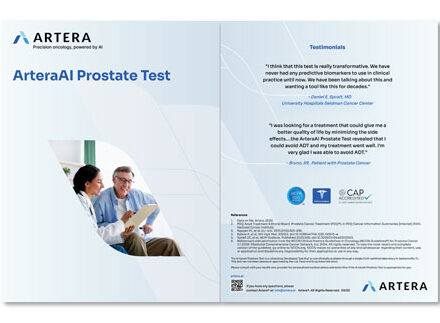IPCSG June 2025 Meeting Summary
Dr. Rajiv Chopra - Founder of Profound Medical and Inventor of the TULSA Procedure - YouTube
Artera AI Prostate Test: Precision Medicine for Treatment Personalization
IPCSG June Meeting Summary - Gabby Caseris, Artera AI
Following Dr. Chopra's TULSA presentation, Gabby Caseris from Artera AI introduced members to a groundbreaking diagnostic tool that's revolutionizing how we approach prostate cancer treatment decisions. This AI-powered test represents a significant advancement in precision medicine, helping men avoid both overtreatment and undertreatment based on their individual cancer characteristics.
Company Background and Development
Artera AI is a young precision medicine company founded just three years ago in the Bay Area through a unique partnership between a UCSF radiation oncologist and the former head of AI at Salesforce. The company's mission is to develop AI-powered tests that personalize treatment decisions for cancer patients, with their prostate test being the first to reach market.
The test has been commercially available for only about a year and available in California since November 2024, making it very new to the market. Despite its recent introduction, Artera AI has already achieved remarkable recognition in the medical community.
Revolutionary Technology: Digital Pathology Meets AI
What sets Artera AI apart from other genomic tests on the market is its innovative approach using digital pathology and artificial intelligence. While traditional tests require extracting RNA from tumor tissue (a process that takes weeks and can fail if insufficient tumor is present), Artera AI uses the same stained slide that the pathologist used for the original diagnosis.
This approach offers several key advantages:
- No tissue consumption: The precious tumor tissue block is preserved for future testing needs
- Zero failure rate: Since cancer cells are already preserved on the slide, there's never a result saying "insufficient tumor tissue for testing"
- Rapid results: 24-36 hours from receipt of slide to results
- Comprehensive analysis: The AI examines every single cell on the biopsy slide
The AI system was trained on thousands of patients from randomized controlled trials, learning to identify patterns by analyzing clinical information, outcomes, and images from biopsy slides. Each slide is divided into tens of thousands of patches, with each patch receiving a score that feeds into the algorithm to generate the final report.
Clinical Applications and Benefits
Prognostic Information (All Patients)
Every patient receives a prognostic assessment including:
- 10-year risk of distant metastasis
- 10-year risk of prostate cancer-specific mortality
- Outcomes based on standard-of-care treatments for their NCCN risk group
Risk-Specific Insights
Very Low to Favorable Intermediate Risk:
- Active surveillance candidacy assessment
- Helps determine if watchful waiting is appropriate
Intermediate Risk - Short-term ADT Biomarker:
- Binary yes/no recommendation for short-term hormone therapy with radiation
- Critical finding: Validation studies showed approximately two-thirds of intermediate-risk men don't benefit from adding hormone therapy to radiation
- This means most men can be spared the side effects and financial burden of unnecessary hormone treatment
High and Very High Risk - Aberadone Biomarker:
- Determines need for aberadone (Zytiga) in addition to radiation and long-term hormone therapy
- Recently presented at ASCO 2025 and selected as "Best of ASCO"
- Key discovery: Only about 25% of high-risk men actually need aberadone addition
- Supports the goal of minimizing overtreatment while personalizing care
Clinical Validation and Recognition
Artera AI has achieved unprecedented recognition for such a new technology:
NCCN Guidelines Inclusion
- Included in 2025 NCCN guidelines with the highest level of evidence
- Listed under "AI pathology" category
- Unique distinction: The only risk stratification test for localized disease recognized to have predictive capabilities
Insurance Coverage
- Medicare: Fully covered with zero out-of-pocket cost
- Commercial insurance: Prior authorizations submitted as needed
- Financial assistance: If non-covered amount exceeds $285, patients can access self-pay rate of $285
- Outstanding coverage: Over 95% of patients applying for financial assistance qualify for zero out-of-pocket costs
Sample Reports and Interpretation
Intermediate Risk Report
The report provides a comprehensive visual display including:
- Prognostic charts showing 10-year distant metastasis risk
- 10-year prostate cancer-specific mortality risk
- Active surveillance candidacy indicator (circle moving along a continuum)
- Short-term ADT biomarker: Binary positive/negative recommendation at bottom of report
High Risk Report
Similar format with:
- Same prognostic information displays
- Aberadone biomarker: Up arrow or down arrow indicating likely benefit from aberadone addition
- Clear visual presentation for easy interpretation
Advantages Over Traditional Approaches
Speed and Efficiency
- Traditional genomic tests: Several weeks processing time
- Artera AI: 24-36 hours turnaround time
Tissue Preservation
- Traditional tests: Consume tumor tissue from biopsy
- Artera AI: Uses existing slides, preserves all tissue for future needs
Failure Rate
- Traditional tests: Can fail due to insufficient tumor tissue
- Artera AI: Zero failure rate since slides already contain preserved cancer cells
Data Foundation
- Massive training datasets: Uses huge patient populations for model training and validation
- Validated outcomes: Based on real patient results from major clinical trials
Impact on Treatment Decision-Making
The Artera AI test addresses a critical need in prostate cancer care: reducing both overtreatment and undertreatment through personalized medicine. Key impacts include:
Reducing Overtreatment:
- Identifies intermediate-risk men who don't need hormone therapy (approximately 67%)
- Determines high-risk men who don't need aberadone addition (approximately 75%)
- Helps avoid unnecessary side effects and costs
Optimizing Treatment:
- Confirms which patients truly benefit from intensified treatment
- Provides confidence in treatment de-escalation decisions
- Supports active surveillance candidacy assessment
Rapid Decision Support:
- 24-hour results enable timely treatment planning
- Reduces delays in starting appropriate therapy
- Allows for quick treatment adjustments
Future Implications
As precision medicine continues to evolve, tools like Artera AI represent the future of cancer care - moving away from one-size-fits-all approaches toward truly individualized treatment plans. The test's inclusion in NCCN guidelines and rapid insurance coverage adoption suggest it will likely become standard of care for newly diagnosed prostate cancer patients.
For IPCSG members, this technology offers hope for more precise treatment decisions that minimize unnecessary treatments while ensuring optimal cancer control. The rapid turnaround time and preserved tissue benefits make it an attractive option for men facing treatment decisions.
Member Questions and Answers
Note: The transcript indicates that due to time constraints, questions for Gabby were taken at the podium after the formal presentation rather than during a recorded Q&A session. Unfortunately, these individual conversations were not captured in the meeting transcript. However, members were encouraged to approach Gabby directly for specific questions about eligibility, insurance coverage, and how the test might apply to their individual situations.
General Questions Likely Addressed:
- How to access the test through their physicians
- Specific insurance coverage details
- Timeline for receiving results
- How the test integrates with existing treatment planning
- Eligibility criteria for different risk categories
- Comparison with other genomic tests they may have heard about
Members interested in learning more about the Artera AI prostate test should discuss it with their urologist or radiation oncologist, as the test requires a physician order and uses existing biopsy materials from their diagnosis.
For more information about Artera AI and their prostate test, members can visit the company website or ask their treatment team about incorporating this diagnostic tool into their care planning.




Comments
Post a Comment